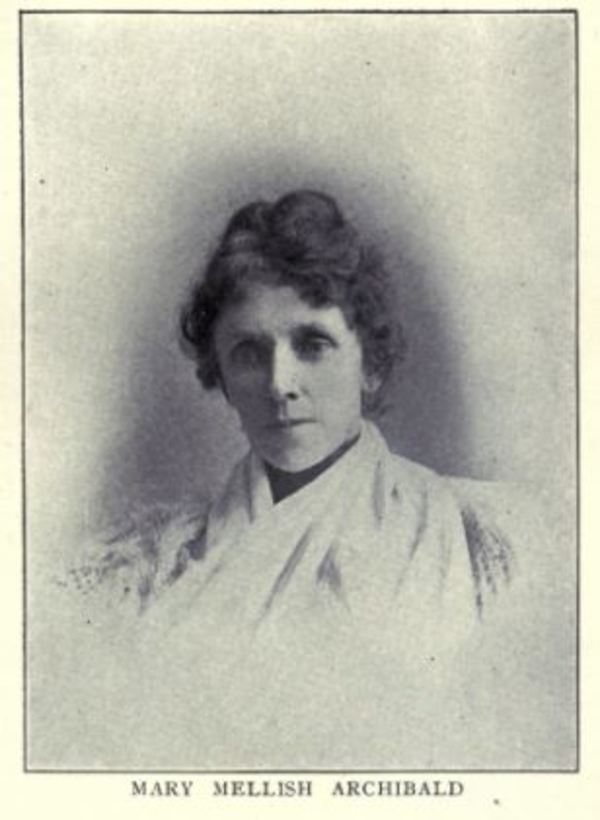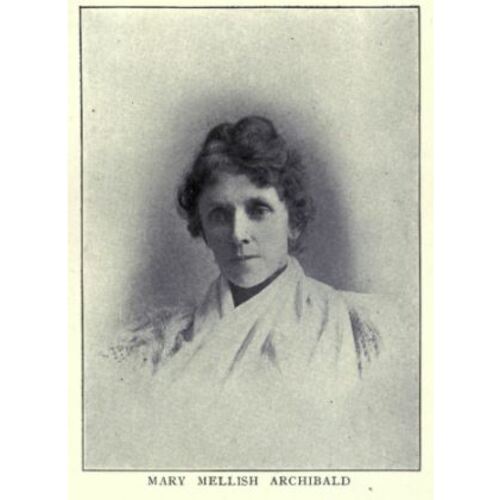
Source: Link
MELLISH, MARY (Archibald), educator; b. 27 Jan. 1849 in Pownal, P.E.I., daughter of James Lewis Mellish and Margaret Sophia Murray; m. there 14 Dec. 1874 Abram Newcomb Archibald, and they had one son, Raymond Clare; d. 9 Jan. 1901 in New York City.
After schooling in Pownal and at the Normal School in Charlottetown, Mary Mellish received her teaching licence in 1864. For the next five years she taught intermittently and worked for a time as a governess. In 1866–67 she attended the ladies’ academy associated with Mount Allison Wesleyan College in Sackville, N.B. [see Humphrey Pickard*], and obtained the diploma of mistress of liberal arts. Returning to Sackville in 1869, she taught mathematics and natural science at the ladies’ academy and from 1871 to 1873 served as chief preceptress – the highest administrative position open to a woman – under Principal James Robert Inch*. Mellish’s resignation on health grounds in 1873 began an 11-year hiatus in her professional career. Following an extended stay in Boston, she went back to Prince Edward Island in 1874 and there married Abram Newcomb Archibald. The nine years of their marriage were mainly spent in Halifax, where her husband served as a school principal before taking up employment with the British American Book and Tract Society. On his death from typhoid in late 1883 she was left with the care of their eight-year-old son. She returned to teaching in the following year at a rural school in Colchester County, N.S., and then in 1885 was reappointed chief preceptress at Mount Allison.
She now emerged quickly as a powerful figure at her institution and in the wider community. Also appointed in 1885, as principal of the ladies’ academy, was the Methodist minister Byron Crane Borden. Although Borden was nominally in authority over Archibald, their relationship was effectively one of partnership. For almost 16 years they presided over a remarkable expansion in the size and role of their institution, including its adoption of the title ladies’ college in 1886. It remained a non-degree-granting institution, however, with undergraduate education available to women at the adjoining Mount Allison College. A later tribute to Archibald described her as “quite capable at times . . . of using the steel hand under the velvet glove,” and this capacity for firm action – along with her skill as a teacher – was a hallmark of her subsequent career. Among the achievements in which she played a leading role were the establishment of a conservatory of music at the ladies’ college in 1891, and the admission in 1895 of alumnae representatives – and hence, for the first time, of women – to the board of governors of the Mount Allison institutions. Archibald herself spent the next five years on the board. As a general strategy, she and Borden attempted to ride the wave of increasing enrolment at the ladies’ college – fuelled by the prosperity of certain industrialized areas of the Maritime provinces, and thus by an increasing volume of urban middle-class applicants – without allowing the institution to become a mere finishing school. Although the contrary pressures were hard to resist, efforts to upgrade the professionalism of teaching in music and fine arts, and to introduce new curricular offerings in such areas as home economics and social science, had a significant effect. Archibald’s contribution to the development of the ladies’ college was recognized in 1897 when her title was changed to vice-principal.
The warmth of the tributes that followed her unexpected death in early 1901, of pneumonia while on a visit to New York City, bore witness to the affection as well as the respect that Mary Mellish Archibald had engendered in colleagues and students alike. She had also been active in the Woman’s Missionary Society of the Methodist Church of Canada and in the Woman’s Christian Temperance Union. Having successfully reshaped her own life in widowhood, she had then endeavoured – within the constraints imposed by social class – to make the Mount Allison ladies’ college an institution through which younger women could in turn take control of theirs.
The Raymond Clare Archibald papers at Mount Allison Univ. Arch. (Sackville, N.B.) include extensive materials on Mary Mellish Archibald, especially in connection with the memorial library established in her name by her son. Biographical details can be found in “Mary Mellish Archibald,” a typescript chronology glued to pp.91–94 of a scrapbook in the Raymond Archibald papers, 5501/10/1. It is unsigned, but was almost certainly prepared by her son. Frequent references to the subject are found in the Mount Allison students’ magazine, the Argosy (Sackville), 1885–1901, and an obituary and account of her funeral appear in the Evening Mail (Halifax), 14 Jan. 1901.
J. G. Reid, “The education of women at Mount Allison, 1854–1914,” Acadiensis (Fredericton), 12 (1982–83), no.2: 3–33; Mount Allison.
Cite This Article
John G. Reid, “MELLISH, MARY (Archibald),” in Dictionary of Canadian Biography, vol. 13, University of Toronto/Université Laval, 2003–, accessed January 1, 2026, https://www.biographi.ca/en/bio/mellish_mary_13E.html.
The citation above shows the format for footnotes and endnotes according to the Chicago manual of style (16th edition). Information to be used in other citation formats:
| Permalink: | https://www.biographi.ca/en/bio/mellish_mary_13E.html |
| Author of Article: | John G. Reid |
| Title of Article: | MELLISH, MARY (Archibald) |
| Publication Name: | Dictionary of Canadian Biography, vol. 13 |
| Publisher: | University of Toronto/Université Laval |
| Year of publication: | 1994 |
| Year of revision: | 1994 |
| Access Date: | January 1, 2026 |



